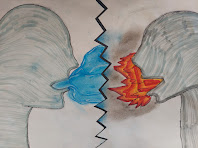Process for Environment:
My storyboard sequence that I will be basing my character design materials off of. The main character will be the girl who is dreaming - her name Cassandra refers to a character in Greco-Roman mythology who was cursed with the ability to see the future, but that no one would believe her. Her dream references the kind of nuclear fallout that Godzilla and the Jellyfish Babies of Bikini Atoll speak to. So I technically have 2 environments, the dream state and the real world. For this program I chose to focus on the Dream State, because it bears the most importance on communicating the horror of our potential future climate reality.
Frame I chose to focus on, to flesh out the quality I want this environment to have:
Once I had a clearer sense of my direction, I created a mood board that helps focus my attention on the most important aspects of communicating the vibe of my story:
1. Textures and Colors - I want this to feel landed in real world enough that we believe the strangeness of scale and colors, so I looked to really organic and recognizable textures to overlay, adding a depth and variety to the environment quickly, without me having to stress over rendering each aspect freehand
2. Flora and Fauna - what kinds of creatures and plant life do I want to populate this environment, to make it feel like it belongs to them - I also really wanted the feel/evidence of human existence to be clearly represented, but with the kind of impersonal incorporation that I associate with natural disasters: Nature doesn't care who or what is in its path, but consumes everything. This was also a place to play with an x-ray quality, since x-rays involve radioactive particles, and gives another hint/layer to the nuclear fall out suggested. I'm looking for ways to reinforce my narrative.
3. An example of how I want the character to be rendered - here I am working with a kind of ghostly quality that lives at the edge of scary and beautiful, but also reinforces the Dream State, or like she is a visitor from another world. I want her and the fish to mirror each other, and they will share characteristics to also help us understand there is a connection - I will dig more into that part of the concept when we look at character sheets
4. Transitioning Between Worlds - the movement between the worlds is the place where the ideas really land, where we are forced to reckon with what could be vs what is - so while I have not chosen to create an environment to bridge that gap, I did feel it was important to have a nod to that aspect of the story, because it informs all of my decisions about characters, elements that cross between etc
Environment Study:
I layered colors and textures on top of my drawing - sometimes I do more of a full on collage style, sometimes I focus more on accentuating my rendering and line quality, but in this one, I was really thinking about the kind of mood I wanted this world to have. I have leaned into poisonous/acidic colors, made the water murky, and vaguely reminiscent of an oil spill - things are flowy and organic, but with sharp edges, and even the afternoon light penetrating the water is a sickly green, revealing massive, dangerous creatures that we as the viewer know the individuals in the tiny boat are probably not aware of - a kind of knowing that gives a sense of foreboding.
Mood Boards I've made for professional projects in Theatre, Film, Music Videos:
An important piece as the Production Designer is making sure my vision aligns with everyone else's on the team - from the Director to the Costume Designer - and even for my Graphic Design clients, I send them a round up of images to get a clearer sense of their personal aesthetic, to make things that genuinely speak to them and the quality they want to convey. Sourcing images to support you as you develop a larger vision is a really important part of being able to see your narrative structures more clearly.
Environment Studies from Professional Concept Artists:














.jpg)
.jpg)
























































